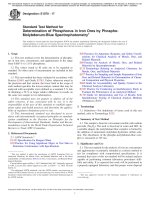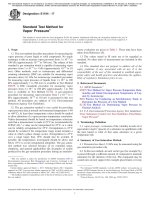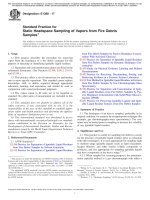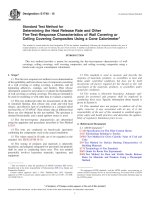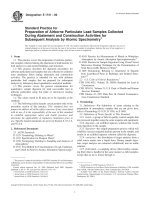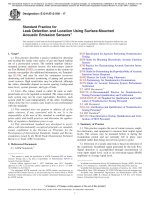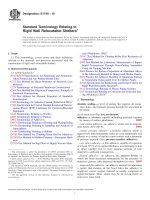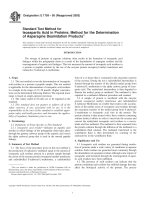Astm e 2942 17
Bạn đang xem bản rút gọn của tài liệu. Xem và tải ngay bản đầy đủ của tài liệu tại đây (93.71 KB, 6 trang )
This international standard was developed in accordance with internationally recognized principles on standardization established in the Decision on Principles for the
Development of International Standards, Guides and Recommendations issued by the World Trade Organization Technical Barriers to Trade (TBT) Committee.
Designation: E2942 − 17
Standard Guide for
Security of Tank Farm Installations for Compliance with
Spill Prevention, Control and Countermeasure Plan (SPCC)
Regulations1
This standard is issued under the fixed designation E2942; the number immediately following the designation indicates the year of
original adoption or, in the case of revision, the year of last revision. A number in parentheses indicates the year of last reapproval. A
superscript epsilon (´) indicates an editorial change since the last revision or reapproval.
INTRODUCTION
Federal Regulation 40 CFR 112.3 requires an owner or operator of certain onshore or offshore
facilities that have tanks used for storing oil to prepare a written Spill Prevention Control and
Countermeasure Plan (SPCC Plan). The SPCC Plan must include a description of the security
measures that are implemented at the facility to prevent unauthorized access to oil handling,
processing, and storage areas. Such security measures may involve fencing, lighting and other more
sophisticated systems.
The SPCC rule defines Tier I and Tier II facilities. The owner/operator of Tier I and certain Tier II
facilities may prepare and self-certify the SPCC Plan. Refer to United States Environmental Protection
Agency - Office of Solid Waste and Emergency Response Spill Prevention, Control and Countermeasure (SPCC) Rule - Stream-lined Requirements for Tier I and Tier II Qualified Facilities for aid in
determining if a particular facility is a qualified Tier I or Tier II facility. If the requirements for
self-certification are not met then the SPCC Plan must be certified by a Professional Engineer (P.E.)
Some states do not permit self-certification of SPCC Plans and thus requires that all SPCC Plans be
certified by a Professional Engineer (P.E.) The owner/operator should check with the state engineering
licensing board to find out if it prohibits SPCC Plan self-certification.
facility uses to prevent releases of petroleum to storm water
discharges. There are several different types of fencing and
lighting that can be effective. The intent of this document is to
outline a method for providing security fencing and lighting
that has been effectively used. There are other fencing and
lighting methods that may be adequately effective. Some
facilities may be considered adequately secure without fencing
or lighting. An analysis of the threat level should be made to
determine the type of security system to employ.
1. Scope*
1.1 This guide covers fencing and lighting only. More
sophisticated security systems may be appropriate for the
facility but discussion of these types of systems is beyond the
scope of this document.
1.2 The information included in this guide is intended for
petroleum bulk storage facilities. It is not intended for use with
retail fueling and other motor fueling facilities, refineries,
chemical plants, docks, oil production facilities, or electric
power generation, transmission, distribution and service center
facilities. Fencing, lighting or other security measures designed
to prevent unauthorized access to the bulk storage facility may
be components of Best Management Practices (BMPs) that the
1.3 Any facilities must meet local, state, and federal
building, architectural, hazardous material handling and
storage, and fire protection codes.
1.4 The values stated in inch-pound units are to be regarded
as standard. No other units of measurement are included in this
standard.
1
This test method is under the jurisdiction of ASTM Committee E50 on
Environmental Assessment, Risk Management and Corrective Action and is the
direct responsibility of Subcommittee E50.01 on Storage Tanks.
Current edition approved Aug. 1, 2017. Published August 2017. Last previous
edition approved in 2015 as E2942–15. DOI: 10.1520/E2942–17
1.5 This international standard was developed in accordance with internationally recognized principles on standardization established in the Decision on Principles for the
*A Summary of Changes section appears at the end of this standard
Copyright © ASTM International, 100 Barr Harbor Drive, PO Box C700, West Conshohocken, PA 19428-2959. United States
1
E2942 − 17
Streamlined Requirements for Tier I and Tier II Qualified
Facilities
2.6 Federal Standards:7
Federal Specification RR-F-191K/GEN Fencing, Wire and
Post Metal (And Gates, Chain Link Fence Fabric, and
Accessories-(General Specification)
RR-F-191/1 Fencing, Wire and Post, Metal (Chain-Link
Fence Fabric)
RR-F-191/2 Fencing, Wire and Post, Metal (Chain- Link
Fence Gates)
RR-F-191/3 Fencing, Wire and Post, Metal (Chain-Link
Fence Posts, Top Rails, and Braces)
RR-F-191/4 Fencing, Wire and Post, Metal (Chain-Link
Fence Accessories)
2.7 Lighting:
NFPA 70 National Electric Code – Introduction, Chapter 1,
Chapter 2, Chapter 3, Chapter 4, Article 410 –
International Building Code Section 1205
Illumination Society of North America
United States Environmental Protection Agency 40 FR
112 Oil Pollution Prevention
Development of International Standards, Guides and Recommendations issued by the World Trade Organization Technical
Barriers to Trade (TBT) Committee.
2. Referenced Documents
2.1 ASTM Standards:2
A121 Specification for Metallic-Coated Carbon Steel
Barbed Wire
A123 Specification for Zinc (Hot-Dip Galvanized) Coatings
on Iron and Steel Products
A392 Specification for Zinc-Coated Steel Chain-Link Fence
Fabric
A567/A567M Specification for Castings, Iron, Cobalt, and
Nickel-Base Alloy, for High Strength at Elevated Temperatures (Withdrawn 1987)3
A817 Specification for Metallic-Coated Steel Wire for
Chain-Link Fence Fabric and Marcelled Tension Wire
F626 Specification for Fence Fittings
F900 Specification for Industrial and Commercial Steel
Swing Gates
F1043 Specification for Strength and Protective Coatings on
Steel Industrial Fence Framework
F1083 Specification for Pipe, Steel, Hot-Dipped ZincCoated (Galvanized) Welded, for Fence Structures
F1184 Specification for Industrial and Commercial Horizontal Slide Gates
2.2 American National Standards Institute/American Petroleum Institute4
ANSI/API Standard 780 Security Risk Assessment Methodology for the Petroleum and Petrochemical Industries
2.3 Chain Link Fence Manufacturers Institute:5
CLF–SFR0111 Security Fencing Recommendations The
Tested and Proven Performance of Security Grade Chain
Link Fencing Systems
CLF-WLG 0110 Chain Link Fence Wind Load Guide for
Selection of Line Post and Line Post Spacing
CLF-PM0610 Product Manual
2.4 United States Department of Transportation:6
AC150/5370 – 10F
Item F-161 – Wire fence With Steel Posts (Class C and D
Fence)
Item F-162 – Chain Link Fence Item
F-163 – Wildlife Deterrent Fence
2.5 United States Environmental Protection Agency:
Federal Regulation 40 CFR 112 Oil Prevention Pollution
Office of Solid Waste and Emergency Response – Spill
Prevention, Control, and Countermeasure (SPCC) Rule –
3. Terminology
3.1 Definitions:
3.1.1 foot candle—is a non-SI unit of illuminance or light
intensity, abbreviated fc, lm/ft2, ft-c.
3.1.1.1 Discussion—The SI unit is lux. One foot candle is
approximately equal to 10.764 lux.
4. Threat Level
4.1 The first step is for the owner to investigate and
determine the perceived threat level. From that determination a
judgment on the type and extent of fencing and the type and
extent of lighting can be made. Helpful references are detailed
in Section 2 above. Contacting the Department of Homeland
Security (DHS) to obtain a security analysis and a vulnerability
study may be helpful. Further contacting the local police
department or sheriff for guidance on security strategies in the
local area based on familiarity with the threat characteristics of
the area will be helpful.
4.2 Another document that may be useful in identifying the
threat level and evaluating the risk involved is ASNI/API
Standard 780 – Security Risk Assessment Methodology for the
Petroleum and Petrochemical Industries.
5. Fencing Systems
5.1 The reference documents describe fencing systems that
are more secure and fencing systems that are less secure. The
owner should perform a risk analysis and determine the
appropriate fencing system for the facilities to be protected.
2
For referenced ASTM standards, visit the ASTM website, www.astm.org, or
contact ASTM Customer Service at For Annual Book of ASTM
Standards volume information, refer to the standard’s Document Summary page on
the ASTM website.
3
The last approved version of this historical standard is referenced on
www.astm.org.
4
Available from American National Standards Institute (ANSI), 25 W. 43rd St.,
4th Floor, New York, NY 10036, .
5
Chain Link Fence Manufacturers Institute (CLFMI) 10015 Old Columbia Rd.
Suite B215 Columbia, MD 21046.
6
United States Department of Transportation, 1200 New Jersey Avenue, SE
Washington, DC 20590 855-368-4200,
NOTE 1—Some fence types may be restricted by local codes.
6. Fencing Details
6.1 A chain-link fence is one type of fencing that has been
used successfully with the type of facilities described in 1.2.
7
DLA Document Services Building 4/D 700 Robbins Avenue Philadelphia, PA
19111-5094 />
2
E2942 − 17
There are other fencing details that will provide adequate
security Refer to Appendix X1 for typical chain-link fence
details.
NOTE 2—Lighting may not be helpful for security where a perpetrator
has no fear of being caught and there are no patrols or other surveillance.
7.3 The lighting system used to provide the required illumination levels should be designed to provide the average
illumination when the lighting is in operation.
7. Illumination
7.1 The illumination values included in Appendix X2 have
been used successfully for these types of facilities. The owner
should determine if other illumination values are better suited
to the facilities involved.
7.2 Facilities should be equipped with lights to prevent acts
of vandalism and to allow facility personnel to discover
discharges that occur at night.
8. Keywords
8.1 fencing; lighting; SPCC plan; tank farm security; tank
farm security fencing; tank farm security lighting
APPENDIXES
(Nonmandatory Information)
X1. CHAIN-LINK FENCING DETAILS
INTRODUCTION
This appendix covers chain-link fencing details. It is being provided for reference only. There are
other details of chain-link fence construction that may be better suited for a particular installation.
Type A external and internal galvanized coatings pipe with
galvanized sleeve type couplings.
X1.1 Type of Fence
X1.1.1 Chain-link fabric, 72 in. high, with tubular top rail,
bottom tension wire, and guard top.
NOTE X1.2—Omitting the top rail can make the fence more difficult to
climb. In this Case a 7 – gauge coil spring wire can be installed in place
of the top rail.
X1.1.2 The guard top is three strands of barbed wire on 45
degree extension arm turned inside.
X1.2.4.2 One coupling in every five should have a 6 in.
sleeve to accommodate temperature take up expansion and
contraction.
X1.1.3 If a wildlife deterrent fence is deemed necessary,
refer to United States Department of Transportation, AC150/
5370 Item F-163 for typical details.
X1.2.5 Bracing:
X1.2.5.1 Brace rail should be 1.666 in. OD per Specification
F1043 and Specification F1043 Group 1A standard weight
galvanized pipe with 3⁄8 in. diameter galvanized truss rods and
truss tighteners.
X1.2 Materials
NOTE X1.1—Zinc coated (hot dipped galvanized) materials are specified below. Some jurisdictions may have regulations prohibiting zinc
coated (hot dipped galvanized) material where zinc is regulated in
stormwater runoff.
X1.2.6 Line Posts:
X1.2.6.1 Line posts should be NPS 2 (2.375 in. O.D.)
Specification F1043 and Specification F1083 Group 1A standard weight galvanized pipe.
X1.2.1 Chain-Link Fabric:
X1.2.1.1 The chain-link fabric should be zinc coated (hot
dipped galvanized) per Specification A392, Class 2, 2 in. mesh,
and of No. 9 gauge steel wire.
(1) The fabric should be weaved before galvanizing.
X1.2.7 Terminal Posts:
X1.2.7.1 Terminal posts (end, pull, and corner posts) should
be NPS 21⁄2 (2.875 in. OD.) Specification F1043 and Specification F1083 Group 1A standazrd weight galvanized pipe.
X1.2.2 Barbed Wire:
X1.2.2.1 The barbed wire should be zinc coated (hot dipped
galvanized) per Specification A121 Class 3, and should be
fabricated from two strands of No. 12 1⁄2 gauge steel wire with
four point No. 14 gauge aluminum barbs spaced on 5 in.
centers.
X1.2.8 Barbed Wire Extension Arms:
X1.2.8.1 Line Post:
(1) Barbed wire extension arms should be fabricated of
pressed steel or malleable iron per Specification F626 Type 1
galvanized in accordance with Specification A123.
(2) Extension arms should be able to withstand a minimum
pull down of 300 lb at the end of the arm.
X1.2.8.2 Terminal Posts:
(1) Barbed wire arms should be fabricated of 11 gauge
(minimum) pressed steel or heavy malleable iron base with 11
gauge (minimum) pressed steel per Specification F626 Type I.
X1.2.3 Bottom Tension Wire:
X1.2.3.1 The bottom tension wire should be zinc coated
(hot dipped galvanized) per Specification A817, Type II, Class,
and of No. 7 gauge steel coil tension wire.
X1.2.4 Top Rail:
X1.2.4.1 The top rail should be 1.660 in. O.D. Specification
F1043 and Specification F1083 Group 1A Regular grade with
3
E2942 − 17
(2) Extension should be galvanized per Specification A123.
(3) Extensions should be able to withstand a minimum pull
down weight of 300 lb and of the force of the barbed wire
stretched to proper tension.
(4) Extensions should be securely fastened to post.
X1.3.3.2 The fabric should be fastened to the line posts with
No. 6 gauge galvanized clip on 14 in. centers or No. 9
galvanized wire on 12 in. centers.
X1.3.3.3 The bottom of the fabric should be set at the top of
the concrete.
X1.2.9 Gate Posts:
X1.2.9.1 Gate posts should be Specification F1043 and
Specification F1043 Group 1A Regular Grade standard weight
galvanized pipe.
X1.2.9.2 The size of the gate post shall be determined from
the maximum width of single leaf gates or by one leaf of
double leaf gates per Specification F900.
X1.3.4 Bottom Tension Wire:
X1.3.4.1 The bottom tension wire should be fastened to the
fabric with No.1 gauge galvanized hog clips on 24 in. centers.
X1.3.5 Tension Bars:
X1.3.5.1 The tension bars should be fastened to the terminal
posts with No. 11 gauge by 1 in. wide galvanized tension bars
and 3⁄8 in. diameter galvanized carriage bolts on approximately
14 in. centers.
X1.2.10 Tension Bars and Bands:
X1.2.10.1 Tension bars for pulling the fence fabric to
terminal posts should be 3⁄4 in. steel bars, hot dipped galvanized
in accordance with Specification F626.
X1.2.10.2 Bands for fastening tension bars to terminal posts
should be 11 gauge by 1 in. wide steel, hot dipped galvanized
in accordance with SpecificationF626.
X1.3.6 Line Posts:
X1.3.6.1 The line posts should be evenly spaced with a
maximum spacing of 10 ft centers and meet the CLF-WLG
0110 Wind Load Guide requirements.
X1.3.7 Bracing:
X1.3.7.1 Bracing should be installed midway between the
top rail and the ground from each terminal post to the first line
post.
X1.3.7.2 Braces should be securely fastened to posts by
heavy galvanized pressed steel connections.
X1.3.7.3 Braces should be trussed from the line post back to
the terminal post with 3⁄8 in. diameter galvanized steel rods.
X1.2.11 Gates:
X1.2.11.1 Swing Gates:
(1) The frame should be NPS 11⁄2 (1.900 in.) OD Specification F1083 and Specification F1043 Group 1A Regular
Grade standard weight galvanized pipe with galvanized
pressed steel or galvanized malleable iron corner ells, riveted
or bolted or welded corners.
(2) The internal bracing should be NPS 1 (1.666 in. OD)
Specification F1083 and Specification F1043 Group 1A Regular Grade standard weight galvanized pipe with 3⁄8 in. diameter
galvanized adjustable truss. Bottom hinge should be galvanized malleable pivot type.
(3) Top hinge should allow the gate to swing 90 degrees to
180 degrees.
(4) The gate should be complete with padlocking device,
center rest, and semi-automatic catch to secure the gate in the
open position.
X1.3.8 Fencing Layout:
X1.3.8.1 Fencing should essentially follow the contour of
the natural grade.
X1.3.8.2 When a space of 6 in. or more occurs between the
bottom of the Chain-link fabric and the ground then intermediate posts should be set at the low point. Tightly stretched
barbed wire should be used to close the space between the
bottom of the chain-link fabric and the ground. There should be
sufficient strands of barbed wire to limit the clear opening
above the ground and between the strands to 3 in.
X1.3.9 Fence Grounding:
X1.3.9.1 Fences in areas crossed by high voltage power
lines should be grounded.
X1.3.9.2 Place one ground connection at the point where the
power lines crosses.
X1.3.9.3 Additional ground connections should be placed
300 ft on either side of the power line crossing.
X1.2.12 Slide Gates:
X1.2.12.1 Slide gates may be the suppliers standard for
width of opening and vertical clearance required per Specification F1184.
X1.3 Installation
X1.3.1 Installation shall meet Specification A567/A567M.
X1.4 Other Information
X1.3.2 Posts:
X1.3.2.1 Posts are set to line and grade in concrete of
sufficient depth to ensure that the fence will remain straight,
not be overturned by wind or other external forces.
X1.3.2.2 Line posts and terminal post footings shall be four
times the largest post section up to 4 in. OD and three times for
larger outside diameters and set at least 36 in. deep.
X1.3.2.3 The concrete should be rounded off to a smooth
appearance approximately 2 in. above soil.
X1.4.1 Listed below are additional ASTM documents related to fencing that may be useful:
A116 Specification for Metallic-Coated, Steel-Woven Wire
Fence Fabric
A153/A153M Specification for Zinc Coating (Hot-Dip) on Iron
and Steel Hardware
A428/A428M Test Method for Weight [Mass] of Coating on
Aluminum-Coated Iron or Steel Articles
A491 Specification for Aluminum-Coated Steel Chain-Link
Fence Fabric
A641/A641M Specification for Zinc–Coated (Galvanized)
Carbon Steel Wire
X1.3.3 Fabric:
X1.3.3.1 The fabric should be fastened to the top rail with
No. 9 gauge aluminum tie wires on 24 in. centers.
4
E2942 − 17
F552 Terminology Relating to Chain Link Fencing
F668 Specification for Polyvinyl Chloride (PVC), Polyolefin
and Other Polymer-Coated Steel Chain Link Fence Fabric
F1553 Guide for Specifying Chain Link Fence
F1664 Specification for Poly(Vinyl Chloride) (PVC) and Other
Conforming Organic Polymer-Coated Steel Tension Wire Used
with Chain-Link Fence
F1665 Standard Specification for Poly(Vinyl Chloride) (PVC)
and Other Conforming Organic Polymer-Coated Steel Barbed
Wire Used With Chain-Link Fence
F1712 Specification for Steel Chain-Link Fencing Materials
Used for High Security Applications (Withdrawn 2015)3
F1999 Practice for Installation of Rigid Poly(Vinyl Chloride)
(PVC) Fence Systems
F2611 Guide for Design and Construction of Chain Link
Security Fencing
X2. ILLUMINATION LEVELS
TABLE X2.1 Lighting Levels
X2.1 Table X2.1 identifies lighting levels that have been
used successfully at the types of facilities described in 1.2.
There are other lighting levels that may be more appropriate for
a particular facility.
Location
Pump Areas – (outdoor)
Pipeways
Walkways and Platforms
Roadways
Stairways
General Areas
Gates
5
Foot Candles
2
2
2
0.4 to 1 d
epending on
activity
2
2
2
Elevation
Ground
Ground
Floor
Ground
Steps
Ground
Ground
E2942 − 17
SUMMARY OF CHANGES
Committee E50 has identified the location of selected changes to this standard since the last issue (E2942–15)
that may impact the use of this standard.
(3) Previous sections 2.2 through 2.6 were renumbered as 2.3
through 2.7.
(1) 2.2 Reference for ANSI/API Standard 780 inserted.
(2) 4.2 Reference for ANSI/API Standard 780 inserted.
ASTM International takes no position respecting the validity of any patent rights asserted in connection with any item mentioned
in this standard. Users of this standard are expressly advised that determination of the validity of any such patent rights, and the risk
of infringement of such rights, are entirely their own responsibility.
This standard is subject to revision at any time by the responsible technical committee and must be reviewed every five years and
if not revised, either reapproved or withdrawn. Your comments are invited either for revision of this standard or for additional standards
and should be addressed to ASTM International Headquarters. Your comments will receive careful consideration at a meeting of the
responsible technical committee, which you may attend. If you feel that your comments have not received a fair hearing you should
make your views known to the ASTM Committee on Standards, at the address shown below.
This standard is copyrighted by ASTM International, 100 Barr Harbor Drive, PO Box C700, West Conshohocken, PA 19428-2959,
United States. Individual reprints (single or multiple copies) of this standard may be obtained by contacting ASTM at the above
address or at 610-832-9585 (phone), 610-832-9555 (fax), or (e-mail); or through the ASTM website
(www.astm.org). Permission rights to photocopy the standard may also be secured from the Copyright Clearance Center, 222
Rosewood Drive, Danvers, MA 01923, Tel: (978) 646-2600; />
6
